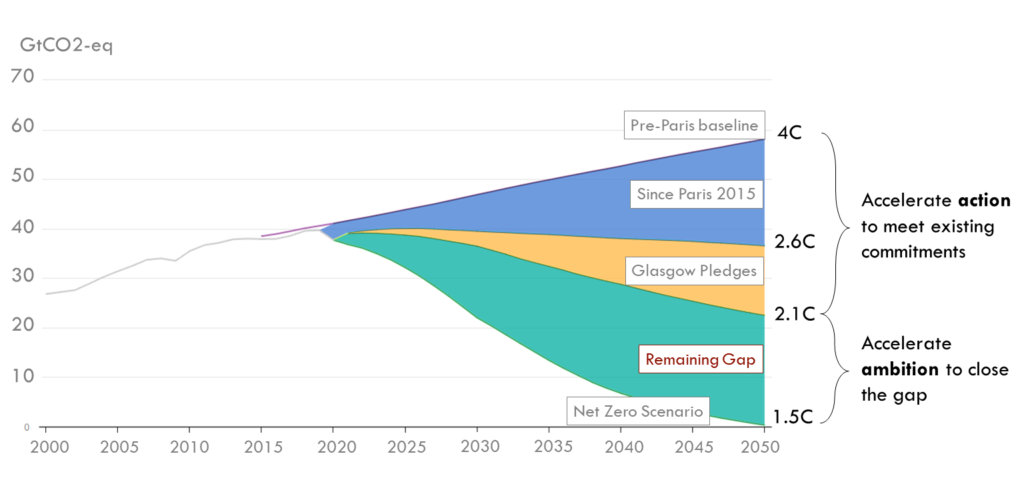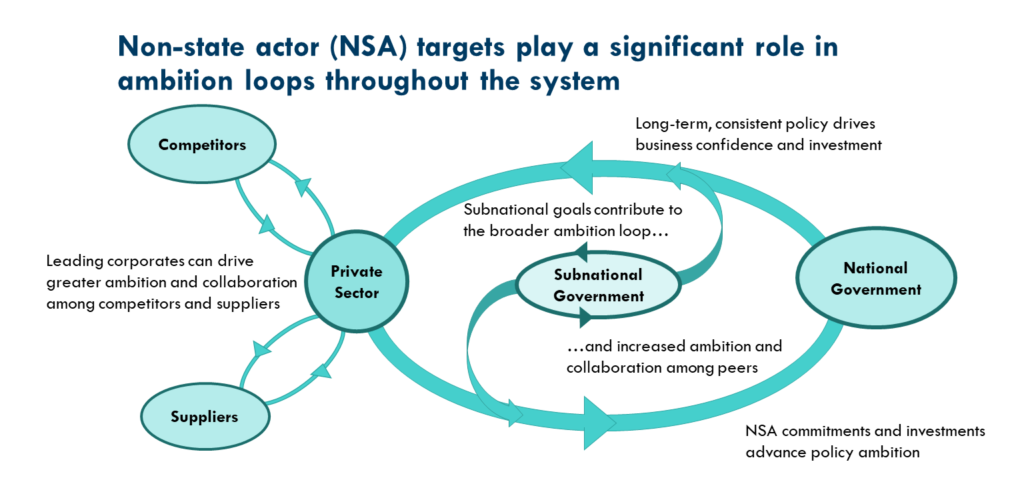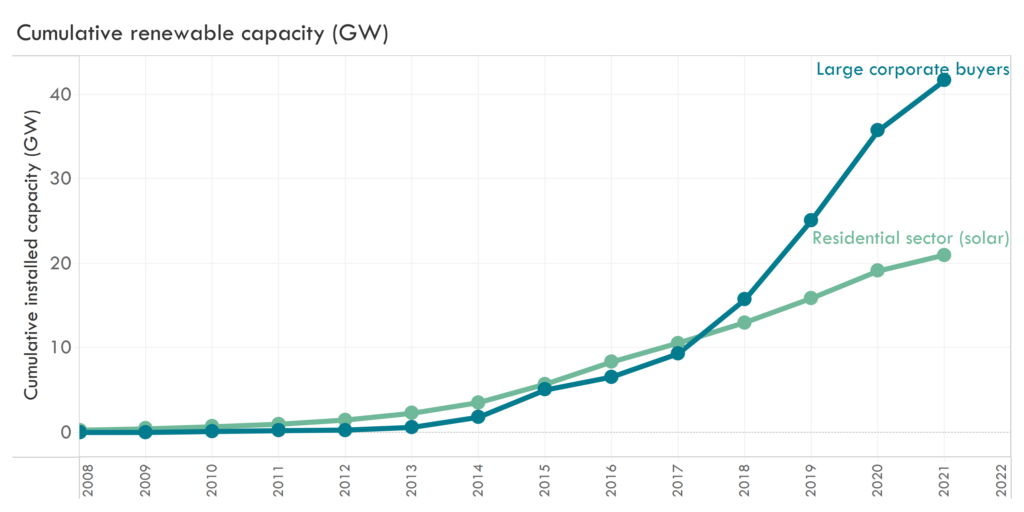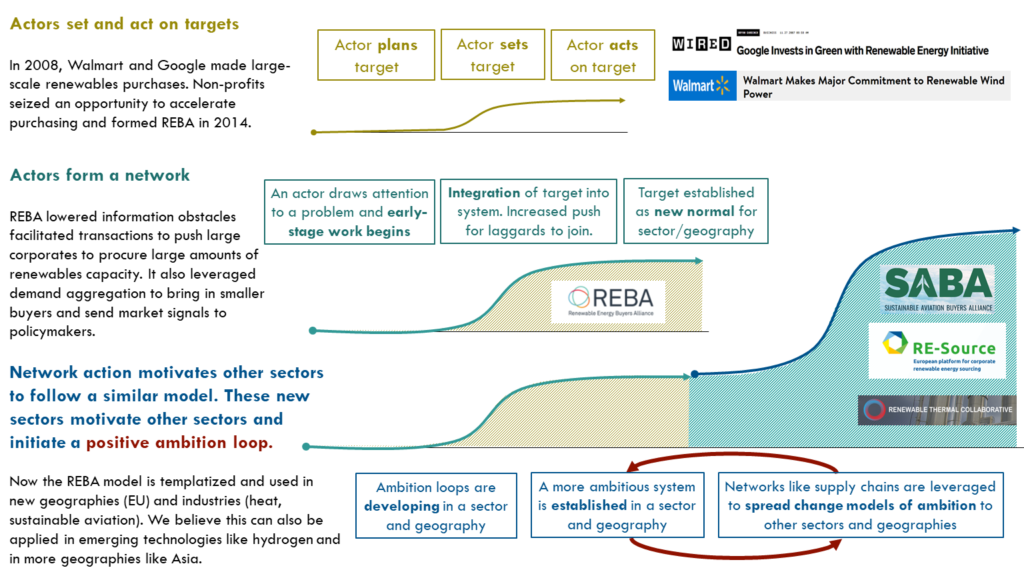Green circular economy concept. Man's hand showing arrow infinity symbol with grass texture and two globes of different colors. (Green circular economy concept. Man's hand showing arrow infinity symbol with grass texture and two globes of different co

We Have the Technology, but Where’s the Ambition?
Corporations, Cities, and Financial Institutions Are Stepping Up to Fill the Climate Ambition Gap
The decreasing costs and improved performance of renewable energy technologies means that it is possible to limit global warming to 1.5°C. According to the International Energy Agency’s (IEA’s) recently released World Energy Outlook, the transition to a net-zero global economy, on a 1.5°C-aligned pathway, would not only avert the worst impacts of climate change but also yield higher economic growth than the current pathway. It would also create 13–24 million net new jobs, reduce premature deaths from air pollution by 2.2 million people a year in 2030, and lower household energy bills.
However, there is still one missing ingredient needed to make this a reality. It isn’t an exotic and costly new technology or other seemingly insurmountable hurdle. What is still missing is the ambition needed to deliver this critically important industrial transition.
The IEA identifies the gap between the 2.1°C outcome we are currently headed for and the 1.5°C goal as the ambition gap. For decades, most experts have assumed that the key to closing this ambition gap would be national governments, working together through multilateral processes like the United Nations Framework Convention on Climate Change. The Paris Agreement marked a major step forward in this process. But in the years since Paris, it has become increasingly clear that national governments alone cannot drive the transition. This is important to keep in mind in the run-up to the 2021 UN Climate Change Conference (COP26)—COP26 cannot be humanity’s last chance for climate action.
Figure source: IEA World Energy Outlook (2021)
To close the ambition gap, we need corporations, cities, and financial institutions to step up. The positive feedbacks these key actors collectively generate in the economy, such as decreasing costs of new technologies and increasing demand in sustainably produced energy, make more ambitious (sub-)national policies possible. This is what is called an ambition loop.
Non-state actors are committing to climate action more decisively than ever before, with more than 6,000 entities signed on to the United Nations’ Race to Zero campaign, which requires them to halve global emissions by 2030. This group represents nearly 15 percent of the global economy and 11 percent of global emissions. In parallel, local and regional policies are advancing rapidly, with increasing state-level ambition in the United States and abroad.
What we need now is: a) a better understanding of the conditions that drive positive ambition loops, b) greater transparency and accountability in turning voluntary commitments into actions, and c) new energy modeling capabilities to integrate ambition loops into energy systems analysis.
Ambition Loops 101
Positive ambition loops describe the dynamics that allow a policy, technology, or idea to rapidly spread across the economy. Under the right circumstances, feedback among diverse actors pressures, inspires, and motivates faster action on climate-related goals.
Ambition Loops Can Deliver Results
Ambition loops are already driving significant climate action in the real economy. In some cases, voluntary actions by leading corporations have kicked off cycles of positive rivalry in the private sector and encouraged significant policy changes affecting multibillion-dollar markets. In the United States, for example, corporate renewable energy procurement increased dramatically beginning in 2014 when a handful of leading corporations began to make commitments to purchase renewable electricity under power purchase agreements (PPA). Between 2010 and 2020, corporate buyers ramped up annual renewables procurements from 0.1 GW to over 10 GW. Procurements in 2020 were equivalent to 40 percent of new carbon-free electricity capacity added that year.
Note: This data represents cumulative renewables capacity additions from large corporate buyers, as tracked by the Renewable Energy Buyers Alliance, and the residential sector’s solar capacity, as tracked by the Solar Energy Industries Alliance. Values in 2021 reflect the first half of the year.
This rapid increase was in large part facilitated by a coordinated effort of the non-profit Renewable Energy Buyers Alliance (REBA). REBA turned climate action by a few leading companies (e.g., Walmart and Google) into an industry-changing movement by reducing information obstacles, particularly those related to PPAs, to enable transactions at scale. Once the network reached a critical threshold of large corporate buyers, it was able to attract and support smaller buyers. Showing the transactive path was well-walked and highlighting demand aggregation played a pivotal role in pushing local and state energy policy. As buyers demanded more regulatory supports, they sent a market signal that new geographic markets needed to open. More recently, REBA’s change model is being applied to other initiatives like the Sustainable Aviation Buyers Alliance (SABA), Renewable Thermal Collaborative, and RE-Source.
Understanding Ambition Loops and Systemic Change
To create ambition loops as REBA has done, we need to speed up action across geographies and sectors. We are currently developing a series of case studies to understand what drives successful ambition loops. In the illustration below, we contextualize our framework using the earlier REBA example.
This framework seeks to answer three questions:
- How can individual actors initiate ambition loops? Climate ambition often starts small. For example, a leading actor commits to dramatically reducing its emissions, a coalition of leading organizations pilot new technologies, or research institutions identify new problems or solutions. Actors with high visibility will catalyze more movement.
- How can ambition loops scale across economies? Individual actions can together lead to changes in the economy that go beyond what regulations and policies require. Coordinated actions across actors result in faster change. We build upon existing research (e.g., from Systemiq, NewForesight, and WRI) to describe how behavioral and economic change can accelerate.
- How can one ambition loop influence others? A single geography or sector is always linked to others via intricate networks, including supply chains, social networks, and geopolitics. This means that climate ambition in in one geography or sector can influence others. There are several factors that determine whether an ambition loop can expand into global systemic change: transparency (whether through fast shared learning or through data accessibility), consistent pressure from the public and advocacy groups, and building networks of coalitions.
By tapping these system dynamics, we can rapidly accelerate decarbonization. This is not only possible but also economically optimal.
Tracking the Impact of Ambition Loops
The economic models that are at the foundation of most global energy systems analysis make little or no provision for voluntary climate actions undertaken by corporations. Yet with thousands of leading companies making such commitments under the Race to Zero, Science Based Targets Initiative, and other frameworks, we have every reason to expect that voluntary action will become an increasingly important force for change, just as it has in US electricity markets.
By increasing transparency and accountability around voluntary commitments, and tracking their potential implications at a systems level, we can gain a better understanding of the real dynamics of climate action in this decisive decade. We are likely to discover that rapid systems change is more readily achieved than conventional models have led us to believe.
RMI is working with partners to develop new analysis and modeling tools aimed at doing just this and making the results widely accessible and useable by all types of stakeholders. This work is underpinned by a library of case studies of ambition loops that spans various sectors and geographies. This is just the beginning of a long process of adapting our analysis tools to reflect new kinds of climate action and behavior. But it is exactly these changes that have the potential to drive exponential change as climate solutions initiated by private companies, governments, and civil society harmonize and gain momentum. Understanding how to create positive ambition loops will be an essential skill in this decisive decade.



